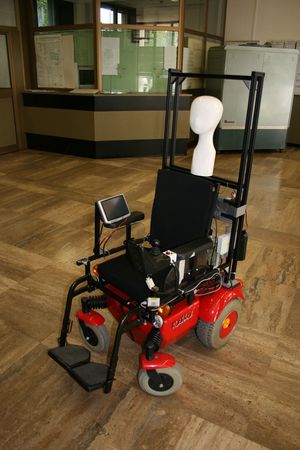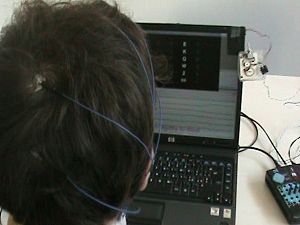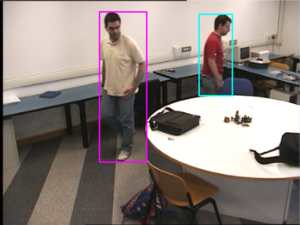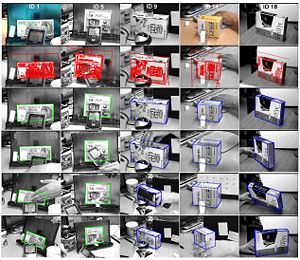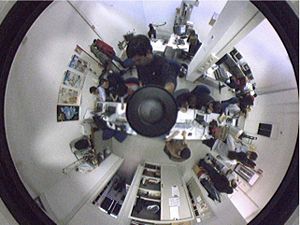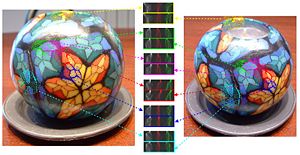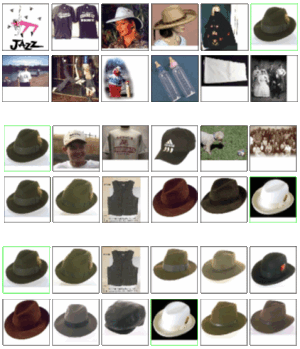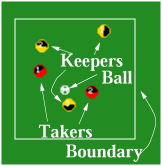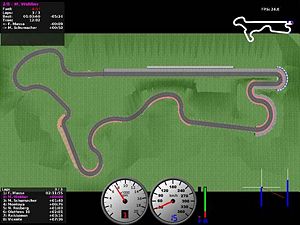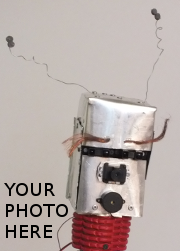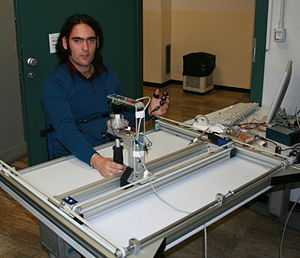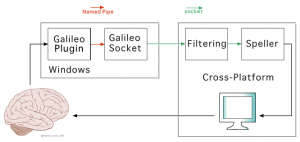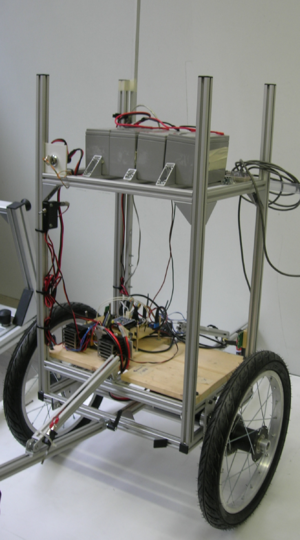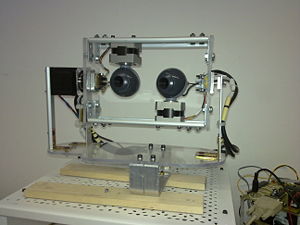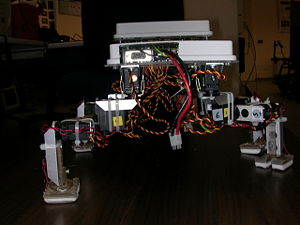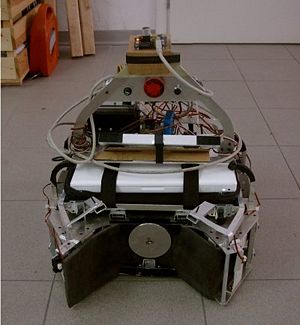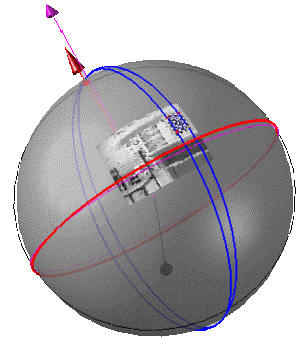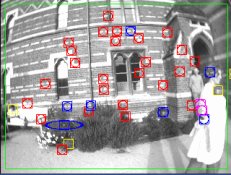Master Level Course Projects
Here you can find a list of project proposals for the courses of "Laboratorio di Intelligenza Artificiale e Robotica" (5 CFU for each student) and "Soft Computing" (1 CFU for each student). See Project Proposals for other kinds of projects and theses.
Contents
Evolutionary Optimization and Stochastic Optimization
| Title: | Combinatorial optimization based on stochastic relaxation | |
|---|---|---|
| Description: | The project will focus on the study, implementation, comparison and analysis of different algorithms for the optimization of pseudo-Boolean functions, i.e., functions defined over binary variables with values in R. These functions have been studied a lot in the mathematical programming literature, and different algorithms have been proposed [1]. More recently, the same problems have been faced in evolutionary computations, with the use of genetic algorithms, and in particular estimation of distribution algorithms [2,3]. Estimation of distribution algorithms are a recent meta-heuristic, where classical crossover and mutation operators used in genetic algorithms are replaced with operators that come from statistics, such as sampling and estimation.
The focus will be on the implementation of existing algorithms able to combine different approaches (estimation and sampling, from one side, and exploitation of prior knowledge about the structure of problem, on the other), together with the comparison of the results with existing techniques that historically appear in different (and often separated) communities. Good coding (C/C++) abilities are required. Since the approach will be based on statistical models, the student is supposed to be comfortable with notions that come from probability and statistics courses. Picture taken from http://www.ra.cs.uni-tuebingen.de/
| |
| Tutor: | Matteo Matteucci ([1]), Luigi Malagò (email) | |
| Start: | Anytime | |
| Number of students: | 1-2 | |
| CFU: | 20-40 |
Evolutionary Computation
| Title: | Combining Estimation of Distribution Algorithms and other Evolutionary techniques for combinatorial optimization | |
|---|---|---|
| Description: | The project will focus on the study, implementation, comparison and analysis of different algorithms for combinatorial optimization using techniques and algorithms proposed in Evolutionary Computation. In particular we are interested in the study of Estimation of Distribution Algorithms [1,2,3,4], a recent meta-heuristic, often presented as an evolution of Genetic Algorithms, where classical crossover and mutation operators, used in genetic algorithms, are replaced with operators that come from statistics, such as sampling and estimation.
The focus will be on the implementation of new hybrid algorithms able to combine estimation of distribution algorithms with different approaches available in the evolutionary computation literature, such as genetic algorithms and evolutionary strategies, together with other local search techniques. Good coding (C/C++) abilities are required. Some background in combinatorial optimization form the "Fondamenti di Ricerca Operativa" is desirable. The project could require some effort in order to build and consolidate some background in MCMC techniques, such as Gibbs and Metropolis samplers [4]. The project could be extended to master thesis, according to interesting and novel directions of research that will emerge in the first part of the work. Picture taken from http://www.genetic-programming.org
| |
| Tutor: | Matteo Matteucci ([2]), Luigi Malagò (email) | |
| Start: | Anytime | |
| Number of students: | 1-2 | |
| CFU: | 5-10 |
Sleep Staging
| Title: | Development of a computer-assisted CAP (Sleep cyclic alternating pattern) scoring method | |
|---|---|---|
| Description: | In 1985, Terzano describes for the first time the Cyclic Alternating Pattern [3] during sleep and, nowadays, CAP is widely accepted by the medical community as basic analysis of sleep. The CAP evaluation is of fundamental importance since it represents the mechanism developed by the brain evolution to monitor the inner and outer world and to assure the survival during sleep. However, visual detection of CAP in polisomnography (i.e., the standard procedure) is a slow and time-consuming process. This limiting factor generates the necessity of new computer-assisted scoring methods for fast CAP evaluation. This thesis deals with the development of a Decision Support System for CAP scoring based on features extraction at multi-system level (by statistical and signal analysis) and Pattern Recognition or Machine Learning approaches. This may allow the automatic detection of CAP sleep and could be integrated, through reinforcement learning techniques, with the corrections given by physicians.
| |
| Tutor: | Matteo Matteucci (email), Martin Mendez (email), Anna Maria Bianchi (email), Mario Terzano (Ospedale di Parma) | |
| Start: | Anytime | |
| Number of students: | 1-2 | |
| CFU: | 5-20 |
BioSignal Analysis
| Title: | Human-computer interaction via voice recognition system | |
|---|---|---|
| Description: | We want develop a system to allow a voice interaction between the user and the wheelchair.
This project consists in develop one of the solutions proposed in literature and extended the LURCH software to include this kind of interface.
References:
| |
| Tutor: | Matteo Matteucci (email), Davide Migliore (email) | |
| Start: | Anytime | |
| Number of students: | 1-2 | |
| CFU: | 2.5-10 |
Brain-Computer Interface
| Title: | Driving an autonomous wheelchair with a P300-based BCI | |
|---|---|---|
| Description: | This project pulls together different Airlab projects with the aim to drive an autonomous wheelchair (LURCH) with a BCI, through the development of key software modules. Depending on the effort the student is willing to put into it, the project can grow to a full experimental thesis.
| |
| Tutor: | Matteo Matteucci (email), Bernardo Dal Seno (email) | |
| Start: | November 2008 | |
| Number of students: | 1 | |
| CFU: | 5-20 |
| Title: | Online automatic tuning of the number of repetitions in a P300-based BCI | |
|---|---|---|
| Description: | In a P300-based BCI, (visual) stimuli are presented to the user, and the intention of the user is recognized when a P300 potential is recognized in response of the desired stimulus. In order to improve accuracy, many stimulation rounds are usually performed before making a decision. The exact number of repetitions depends on the user and the goodness of the classifier, but it is usually fixed a-priori. The aim of this project is to adapt the number of repetitions to changing conditions, so as to achieve the maximum accuracy with the minimum time.
Depending on the effort the student is willing to put into it, the project can grow to a full experimental thesis.
| |
| Tutor: | Matteo Matteucci (email), Bernardo Dal Seno (email) | |
| Start: | Anytime | |
| Number of students: | 1 | |
| CFU: | 5-20 |
| Title: | Reproduction of an algorithm for the recognition of error potentials | |
|---|---|---|
| Description: | Error potentials (ErrPs) are event-related potentials present in the EEG (electroencephalogram) when a subject makes a mistake or when the machine a subject is interacting with works in an expected way. They could be used in the BCI field to improve the performance of a BCI by automatically detecting classification errors.
The project aims at reproducing algorithms for ErrP detection from the literature.
| |
| Tutor: | Matteo Matteucci (email), Bernardo Dal Seno (email) | |
| Start: | This project has already been assigned | |
| Number of students: | 1 | |
| CFU: | 5-15 |
Computer Vision and Image Analysis
| Title: | Environment Monitoring | |
|---|---|---|
| Description: | The goal of this project is to develop a video surveillance system to track in 3D vehicles or people.
The idea is to use one or more calibrated camera to estimate the position and the trajectories of the moving objects in the scene. The skills required for this project are:
The project can be turned into a thesis extending the algorithm for a generic outdoor environment. | |
| Tutor: | Matteo Matteucci (email), Davide Migliore (email) | |
| Start: | Anytime | |
| Number of students: | 2-3 | |
| CFU: | 10-15 |
| Title: | Visual Merchandising | |
|---|---|---|
| Description: | The goal of this project is to develop algorithms to count the number of products on the shelves of a market.
The idea is to use a calibrated camera to recognize the shelves, estimate the scale and improve the image quality. The skills required for this project are:
| |
| Tutor: | Matteo Matteucci (email), Davide Migliore (email) | |
| Start: | As soon as possible | |
| Number of students: | 2-3 | |
| CFU: | 2.5-15 |
| Title: | Analysis of patch recognition algorithms | |
|---|---|---|
| Description: | Extract distinctive features from images is very important in computer vision application.
It can be used in algorithms for tasks like matching different views of an object or scene (e.g. for stereo vision) and object recognition. The aim of this work is to integrate in an existent framework the existing solution proposed in literature. Skills
References: | |
| Tutor: | Matteo Matteucci (email), Davide Migliore (email) | |
| Start: | Anytime | |
| Number of students: | 2-3 | |
| CFU: | 2.5-15 |
| Title: | Catadioptric MonoSLAM | |
|---|---|---|
| Description: | The goal of this work is to investigate a SLAM solutions based on catadioptric camera, integrating the solution presented in literature into an existing frameword.
Improvements could be the basis for a tesi. Skills
References: | |
| Tutor: | Matteo Matteucci (email), Davide Migliore (email) | |
| Start: | Anytime | |
| Number of students: | 2-3 | |
| CFU: | 2.5-15 |
| Title: | Trinocular Vision System (SUGR) | |
|---|---|---|
| Description: | A Trinocular Vision System is a device composed by three cameras that allows to measure 3D data (in this case segments) directly from images.
The aim of this tesina/project is to implement a trinocular algorithm based on SUGR, a library for Uncertain Projective Geometry. Skills
| |
| Tutor: | Matteo Matteucci (email), Davide Migliore (email) | |
| Start: | As soon as possible | |
| Number of students: | 2-3 | |
| CFU: | 2.5-15 |
| Title: | GIFT and features extraction and description | |
|---|---|---|
| Description: | The idea is to improve and optimize the solution proposed by Campari et al. in their paper, who propose to estimate invariant descriptor using geodesic features descriptor based on color information.
Skills
| |
| Tutor: | Matteo Matteucci (email), Davide Migliore (email) | |
| Start: | Anytime | |
| Number of students: | 1-3 | |
| CFU: | 10-20 |
| Title: | Multimedia Indexing Framework | |
|---|---|---|
| Description: | The goal of this project is to develop a framework for multimedia indexing.
The idea is create an images database indexer that allows to make query using images or strings. Skills
References: | |
| Tutor: | Matteo Matteucci (email), Davide Migliore (email) | |
| Start: | Anytime | |
| Number of students: | 1-3 | |
| CFU: | 2.5-15 |
Machine Learning
| Title: | Statistical inference for phylogenetic trees | |
|---|---|---|
| Description: | The project will focus on the study, implementation, comparison and analysis of different statistical inference techniques for phylogenetic trees. Phylogenetic trees [1, 2, 3] are evolutionary trees used to represent the relationships between different species with a common ancestor. Typical inference task concern the construction of a tree starting from DNA sequences, involving both the choice of the topology of the tree (i.e., model selection) and the values of the parameters (i.e., model fitting). The focus will be a probabilistic description of the tree, given by the introduction of stochastic variables associated to both internal nodes and leaves of the tree.
The project will focus on the understanding of the problem and on the implementation of different algorithms, so (C/C++ or Matlab or R) coding will be required. Since the approach will be based on statistical models, the student is supposed to be comfortable with notions that come from probability and statistics courses. Picture taken from http://www.tolweb.org/tree/
| |
| Tutor: | Matteo Matteucci ([17]), Luigi Malagò (email) | |
| Start: | Anytime | |
| Number of students: | 1-2 | |
| CFU: | 20-40 |
| Title: | Reinforcement Learning Competition | |
|---|---|---|
| Description: | This project has the goal of participating to (and possibly winning ;)) the 2009 Reinforcement Learning competition. To have an idea of what participate to such a competition means you can have a look at the website of the 2008 RL competition.
The problems that will be proposed are still unknown. As soon as the domains will be published, the work will start by analyzing their main characteristics and, then we will identify which RL algorithms are most suited for solving such problems. After an implementation phase, the project will required a long experimental period to tune the parameters of the learning algorithms in order to improve the performance as much as possible. | |
| Tutor: | Marcello Restelli (restelli-AT-elet-DOT-polimi-DOT-it) | |
| Start: | January, 2009 | |
| Number of students: | 2-4 | |
| CFU: | 10-20 |
| Title: | Learning API for TORCS | |
|---|---|---|
| Description: | TORCS is a state-of-the-art open source racing simulator that represents an ideal bechmark for machine learning techniques. We already organized two successfull competitions based on TORCS where competitors have been asked to develop a controller using their preferred machine learning techniques. The goal of this project is to extend the existing C++ API (available here) to simplify the development of controller using a learning framework.
Such an extension can be partially developed by porting an existing Java API for TORCS that already provides a lot of functionalities for machine learning approaches. | |
| Tutor: | Daniele Loiacono (loiacono-AT-elet-DOT-polimi-DOT-it) | |
| Start: | Anytime | |
| Number of students: | 1 to 2 | |
| CFU: | 5 to 12.5 |
| Title: | EyeBot | |
|---|---|---|
| Description: | TORCS is a state-of-the-art open source racing simulator that represents an ideal bechmark for machine learning techniques. We already organized two successfull competitions based on TORCS where competitors have been asked to develop a controller using their preferred machine learning techniques. So far, the controller developed for TORCS used as input only information extracted directly from the state of the game. The goal of this project is to extend the existing controller API (see here) to use the visual information (e.g. the screenshots of the game) as input to the controllers. A successfull project will include both the development of the API and some basic imaga preprocessing to extract information from the images. | |
| Tutor: | Daniele Loiacono (loiacono-AT-elet-DOT-polimi-DOT-it), Alessandro Giusti (giusti-AT-elet-DOT-polimi-DOT-it), and Pierluigi Taddei (taddei-AT-elet-DOT-polimi-DOT-it) | |
| Start: | Anytime | |
| Number of students: | 1 to 2 | |
| CFU: | 5 to 20 |
| Title: | SmarTrack | |
|---|---|---|
| Description: | The generation of customized game content for each player is an attractive direction to improve the game experience in the next-generation computer games. In this scenario, Machine Learning could play an important role to provide automatically such customized game content.
The goal of this project is to apply machine learning techniques for the generation of customized tracks in TORCS, a state-of-the-art open source racing simulator. The project include different activities: the automatic generation of tracks, the section of relevant features to characterize a track and the analysis of an interest measure. | |
| Tutor: | Daniele Loiacono (loiacono-AT-elet-DOT-polimi-DOT-it) | |
| Start: | Anytime | |
| Number of students: | 1 to 2 | |
| CFU: | 5 to 20 |
| Title: | TORCS competition | |
|---|---|---|
| Description: | TORCS is a state-of-the-art open source racing simulator that represents an ideal bechmark for machine learning techniques. We already organized two successfull competitions based on TORCS where competitors have been asked to develop a controller using their preferred machine learning techniques.
The goal of this project is to apply any machine learning technique to develop a successfull controller following the competition rules (available here) | |
| Tutor: | Daniele Loiacono (loiacono-AT-elet-DOT-polimi-DOT-it) | |
| Start: | Anytime | |
| Number of students: | 1 | |
| CFU: | 5 |
Ontologies and Semantic Web
Wiki Analysis
| Wiki Page: | A Unifying Framework for Semantic Annotation | ||||||||
| Title: | A Unifying Framework for Semantic Annotation | ||||||||
| Description: | See http://davide.eynard.it/elc/ | ||||||||
| Coordinator: | DavideEynard (
Results might not be as expected. ) | ||||||||
| Tutor: | |||||||||
| Collaborator: | |||||||||
| Students: | |||||||||
| Start: | |||||||||
| End: | |||||||||
| Research Area: | Social Software and Semantic Web | ||||||||
| Research Topic: | Semantic Annotations |
| Wiki Page: | A tool to find and store annotations into a unifying semantic ontology | ||||||||||||
| Title: | A tool to find and store annotations into a unifying semantic ontology | ||||||||||||
| Description: | |||||||||||||
| Coordinator: | DavideEynard (
Results might not be as expected. ) | ||||||||||||
| Tutor: | |||||||||||||
| Collaborator: | |||||||||||||
| Students: | |||||||||||||
| Start: | |||||||||||||
| End: | |||||||||||||
| Research Area: | Social Software and Semantic Web | ||||||||||||
| Research Topic: | Semantic Annotations |
| Wiki Page: | AGW | ||||||||||||
| Title: | AGW - Automatic Guided Wheelchair | ||||||||||||
| Description: | Control system design of an electric wheelchair for autonomous drive with obstacle avoidance | ||||||||||||
| Coordinator: | MatteoMatteucci (
Results might not be as expected. ) | ||||||||||||
| Tutor: | |||||||||||||
| Collaborator: | |||||||||||||
| Students: | |||||||||||||
| Start: | |||||||||||||
| End: | |||||||||||||
| Research Area: | Robotics | ||||||||||||
| Research Topic: | Robot development |
| Wiki Page: | Adaptive Behaviors for Robogames | ||||
| Title: | Adaptive Behaviors for Robogames | ||||
| Description: | The goal of the project is to develop a system to adapt behaviors of a robot to the way of playing of a human player | ||||
| Coordinator: | EwertonLopes (
Results might not be as expected. ) | ||||
| Tutor: | |||||
| Collaborator: | |||||
| Students: | |||||
| Start: | |||||
| End: | |||||
| Research Area: | Robotics | ||||
| Research Topic: | Robot development |
| Wiki Page: | Adaptive Predicates | ||||
| Title: | Adaptive Predicates | ||||
| Description: | Adapting predicates to the robot needs | ||||
| Coordinator: | AndreaBonarini (
Results might not be as expected. ) | ||||
| Tutor: | |||||
| Collaborator: | |||||
| Students: | |||||
| Start: | |||||
| End: | |||||
| Research Area: | Robotics | ||||
| Research Topic: | Robot development |
| Wiki Page: | Affective Robot force sensor | ||||||||
| Title: | Affective Robot force sensor | ||||||||
| Description: | Implementation of a new force sensor for the robot used in affective rehabilitation | ||||||||
| Coordinator: | SimoneTognetti (
Results might not be as expected. ) | ||||||||
| Tutor: | |||||||||
| Collaborator: | |||||||||
| Students: | |||||||||
| Start: | |||||||||
| End: | |||||||||
| Research Area: | Robotics | ||||||||
| Research Topic: | Robot development |
| Wiki Page: | Affective Robotic Rehabilitation of Upper Limbs | ||||
| Title: | Affective Robotic Rehabilitation of Upper Limbs | ||||
| Description: | Evaluation of the affective status of people involved in robotic rehabilitation | ||||
| Coordinator: | MaurizioGarbarino (
Results might not be as expected. ) | ||||
| Tutor: | |||||
| Collaborator: | |||||
| Students: | |||||
| Start: | |||||
| End: | |||||
| Research Area: | BioSignal Analysis | ||||
| Research Topic: | Affective Computing And BioSignals |
| Wiki Page: | Affective VideoGames | ||||||||
| Title: | Affective VideoGames | ||||||||
| Description: | |||||||||
| Coordinator: | SimoneTognetti (
Results might not be as expected. ) | ||||||||
| Tutor: | |||||||||
| Collaborator: | |||||||||
| Students: | |||||||||
| Start: | |||||||||
| End: | |||||||||
| Research Area: | Affective Computing | ||||||||
| Research Topic: | Affective Computing And BioSignals |
| Wiki Page: | Alien-Bot | ||||
| Title: | Alien-Bot | ||||
| Description: | The goal of the project is to develop an interactive game between an autonomous robot and a remotely-controlled one, based on the metaphor of the movie Alien. | ||||
| Coordinator: | AndreaBonarini (
Results might not be as expected. ) | ||||
| Tutor: | |||||
| Collaborator: | |||||
| Students: | |||||
| Start: | |||||
| End: | |||||
| Research Area: | Robotics | ||||
| Research Topic: | Robogames |
| Wiki Page: | Autonomous Robot for emotional interaction | ||||
| Title: | Autonomous Robot for emotional interaction | ||||
| Description: | Expressing emotions in interaction with children wih disabilities. | ||||
| Coordinator: | AndreaBonarini (
Results might not be as expected. ) | ||||
| Tutor: | |||||
| Collaborator: | |||||
| Students: | |||||
| Start: | |||||
| End: | |||||
| Research Area: | Robotics | ||||
| Research Topic: | Robot development |
| Wiki Page: | BCI & artifacts | ||||
| Title: | BCI and artifacts | ||||
| Description: | BCI and artifacts | ||||
| Coordinator: | MatteoMatteucci (
Results might not be as expected. ) | ||||
| Tutor: | |||||
| Collaborator: | |||||
| Students: | |||||
| Start: | |||||
| End: | |||||
| Research Area: | BioSignal Analysis |
| Wiki Page: | BCI based on Motor Imagery | ||||||||||||
| Title: | BCI based on Motor Imagery | ||||||||||||
| Description: | This project is aimed is to control an external device through the analysis of brain waves measured on the human scalp. | ||||||||||||
| Coordinator: | MatteoMatteucci (
Results might not be as expected. ) | ||||||||||||
| Tutor: | |||||||||||||
| Collaborator: | |||||||||||||
| Students: | |||||||||||||
| Start: | |||||||||||||
| End: | |||||||||||||
| Research Area: | BioSignal Analysis |
| Wiki Page: | BCI on Sockets | ||||
| Title: | BCI on Socket | ||||
| Description: | Communication on TCP/IP between BCI Software modules | ||||
| Coordinator: | MatteoMatteucci (
Results might not be as expected. ) | ||||
| Tutor: | |||||
| Collaborator: | |||||
| Students: | |||||
| Start: | |||||
| End: | |||||
| Research Area: | BioSignal Analysis | ||||
| Research Topic: | Brain-Computer Interface |
| Wiki Page: | Balancing robots: Tilty, TiltOne | ||||
| Title: | BalancingRobots | ||||
| Description: | Meta-project about balancing robots. | ||||
| Coordinator: | MartinoMigliavacca (
Results might not be as expected. ) | ||||
| Tutor: | |||||
| Collaborator: | |||||
| Students: | |||||
| Start: | |||||
| End: | |||||
| Research Area: | Robotics | ||||
| Research Topic: | Robot development |
| Wiki Page: | Ballbot | |||||||||||||||||||||||||||||||||||||||||||||||||||||||||||||||||||||||||||||||||||||||||||||||||||||||||||||||||||||||||||||||||||||||||||||||||||||||||||||||||||||||||||||||||||||||||||||||||||||||||||||||||||||||||||||||||||||||||||||||||
| Title: | Ballbot | |||||||||||||||||||||||||||||||||||||||||||||||||||||||||||||||||||||||||||||||||||||||||||||||||||||||||||||||||||||||||||||||||||||||||||||||||||||||||||||||||||||||||||||||||||||||||||||||||||||||||||||||||||||||||||||||||||||||||||||||||
| Description: | A unicycle robot, running on a ball | |||||||||||||||||||||||||||||||||||||||||||||||||||||||||||||||||||||||||||||||||||||||||||||||||||||||||||||||||||||||||||||||||||||||||||||||||||||||||||||||||||||||||||||||||||||||||||||||||||||||||||||||||||||||||||||||||||||||||||||||||
| Coordinator: | [[:User:Roberto Sannino ({{#ask: [[User:Roberto Sannino| ?Email= }}), Daniele Caltabiano|Roberto Sannino (
Robotics
|



